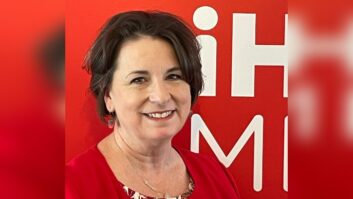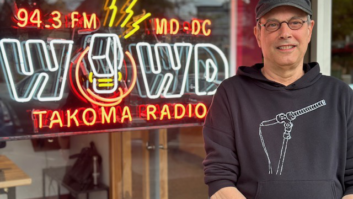
Ribbon-cutting for KUBU(LP), “The Voice of Sacramento Radio” in November 2014.
Credit:
Photo courtesy Jeff Shaw Low-power FM faithful expect 2015 to be the year of major station build-outs — a flurry of facility launches as community broadcasters stake claim to more space on the FM band.
At the same time, advocates are watching how these new broadcasters raise money for equipment, adapt to new management strategies and create peer support groups.
Close to 2,000 new LPFMs could be on air within 18 months as result of the application filing window in 2013, LPFM advocates estimate. About 150 of those are now on the air.
Observers said the FCC was quick to assess and process LPFM applications during the past year. The commission in early 2014 began issuing construction permits where there was only one clear, qualified applicant. In fact, CP grants for LPFMs were seemingly “fast-tracked” in 2014, according to several observers.
The commission is expected to finish sorting through the mutually exclusive, or MX, applications from that filing window in the first half of 2015, according to observers. MX applications are cases where entities are vying for the same frequency. Conflicts among MX applications can be resolved by technical amendments eliminating mutual exclusivity, by settlement or by timeshare agreement. The MX period thus brings a lot of negotiation, coordination and amendment filing among hopeful low-power broadcasters.
Two regional MX settlement windows have closed, according to the FCC. Observers believe the agency will open a final MX settlement window, covering mostly southern states, by early 2015. This will include several large MX groupings in desirable areas like Houston, Dallas/Fort Worth and Orlando, observers said.
LONG-AWAITED WINDOW
FCC LPFM POINT SYSTEM
The commission uses a point system to award LPFM CP grants in cases of mutually exclusive applications where competing groups cannot resolve. According to Tracy Rosenberg, executive director of Media Alliance, points are awarded for:
1) An established presence in the community as a 501c3 organization for at least two years;
2) A pledge to air at least 8 hours a day of locally originated programming;
3) A pledge to maintain a local main studio that is inside the signal area, publicly accessible and able to generate locally originated programming from that site;
4) Qualifying under points 2 and 3 in the same application, which earns an extra point;
5) Having no interest in any other broadcast outlet;
6) Being a tribal applicant that plans to broadcast on tribal lands.
Rosenberg said many LPFM applicants in the recent window worked hard to make sure they could maximize their number of points in the 4-to-5 range to be competitive for a license.
“Sometimes two applicants will join together and merge their applications in order to combine the points in both original applications and thus achieve a higher total number,” she said. “The final FCC decision is awarded on the basis of which application has the highest number of points.”
If there is a tie and no voluntary sharing agreement, Rosenberg said, the commission will determine a sharing agreement.
“Most people agree that voluntary sharing agreements are more likely to work out well than involuntary ones. In most cases, an objection or petition to deny will be filed on the basis that competing applicants have been awarded points they don’t deserve,” Rosenberg said.
— Randy J. Stine
Space on the FM dial remains a sought-after commodity, and some settlements of MX applications could take years to work out. If voluntary timeshare agreements can’t be reached among the mutually exclusive applicants, a commission point system point system is used to determine the grantee. The system is a set of criteria used to score applications and break ties (see sidebar).
Low-power FM stations, which broadcast at a maximum of 100 watts and typically reach seven to 10 miles from the antenna, must be licensed to non-profit entities. These proliferating new micro FM stations promise to air programming that ranges from art and culture to education and hobbies with a hyper-local focus. Churches, civic groups and foreign-language stations make up a large number of the CPs.
For instance, the Center for Hmong Arts and Talent in St. Paul, Minn., aims to nurture, explore and illuminate the Hmong American experience through artistic expression, according to its website. The Flint Odyssey House in Flint, Mich., is concerned about addiction services and drug education; the Women’s Civic Improvement Club of Sacramento, Inc., in Sacramento, Calif., will air programming related to the group’s work in the community, according to the website Radio Survivor.
In the first LPFM window 15 years ago, 3,258 applications were filed; from that pool, the number of LPFMs on the air in the United States, according to FCC data, stood at about 800 just prior to the more recent window.
The second window produced 2,826 LPFM applications. Of those, 628 were dismissed because of errors and omissions, leaving 2,198 to be considered; out of those, approximately 150 new stations are now on the air, and an additional 1,196 hold CPs, according to consultancy Christian Community Broadcasters.
Thus the total number of LPFMs now on the air stood at about 950 as of December 2014, and it will grow quickly. The entities holding CPs have 18 months to get their stations on the air, according to the commission. That can be extended to 36 months upon showing “good cause.”
PROLIFERATION
LPFM hopefuls had waited an extended period between the filing windows due to a backlog of applications from a 2003 FM translator filing window, LPFM advocates said; that backlog is mostly cleared.
The second window generated strong interest from non-profit organizations including schools, churches, public safety agencies and other eligible groups, they said.
The window “allowed for more LPFM services to proliferate, especially in smaller markets and rural areas where many open channels were,” said Todd Urick, program director for Common Frequency, an LPFM and college radio advocate and consultant. “My big disappointment is that many first-time applicants had engineering errors within their applications.”
According to REC Networks, another community radio advocate, 202 of the dismissals were for technical reasons.
Urick cited several examples of groups who saw their applications dismissed due to minor engineering errors, including a food bank and low-income family non-profit in Redding, Calif., called People for Progress.
The year 2015 will be a big build-out year, according to Urick. “However, I think there will be some organizations in over their heads as to their preparedness in licensing these facilities. They’ll need to fundraise at least $5,000 to scrape together the minimal equipment needed to get one on the air. That might be a hurdle for small organizations,” Urick said.

Volunteers raise mast and antenna for KMRD(LP) on the crest of a hill above Madrid, N.M., in October 2014. URBAN GROWTH
The number of CPs being granted in urban areas surprised some LPFM analysts. They noted that the commission is allowing use of second-adjacent channel waivers in hope of establishing additional LPFMs in large markets.
The Local Community Radio Act, signed by President Obama after its passage by Congress in late 2010, authorized the commission to eliminate third-adjacent channel LPFM spacing requirements and allowed the agency to create standards for waiving second-adjacent channel protection requirements.
The FCC has granted hundreds of second-adjacent channel spacing requirement waivers. One source with knowledge of the commission said some full-power FMs are challenging those requests.
“We have seen substantial LPFM growth in urban areas such as Denver, Seattle and Portland. Even New York City is getting a two-way voluntary share station,” said Michi Bradley, founder of community radio advocate REC Networks. In New York, the Roman Catholic Diocese of Brooklyn and the Global Service Center for Quitting the Chinese Communist Party will share 105.5 MHz. “I do feel that there has been a proportionate distribution of CPs in urban and rural areas,” she said. However, large MX groups in Los Angeles, San Francisco and Portland could take months, if not years, to resolve, she said.
Bradley, who worked with a variety of community groups seeking LPFM licenses such as ARTxFM in Louisville, Ky., doesn’t think the 2013 window will yield more than 2,000 CPs and potential LPFM stations.
“Considering that in the third MX window we have several large MX groups, I would expect to see a lot of dismissals from non-tentative selectees. Based on this, breaking 2,000 grants is not likely.”
Prometheus Radio Project, an LPFM advocate and consultant, completed its first station build of a low-power FM that applied in the 2013 application window in October 2014. Prometheus helped coordinate construction of KMRD(LP) in Madrid, N.M., including the installation of transmission equipment, a mast and antenna.
Madrid Community Radio will be a “grassroots effort contributing to democratizing Santa Fe County,” according to the Prometheus website. A blacksmith fabricated a steel cage, hinging base and a 26-foot steel mast to support KMRD’s Norwalk Electronics Dominator NWE-34 antenna. A volunteer electrician and solar expert built a solar system to power the transmission equipment at the transmitter site.
An electronics expert is building a broadcast console from a kit obtained from Kaatskit and organizers hoped to have the station on the air by the end of 2014, according to Prometheus.
Sanjay Jolly, Prometheus Radio Project’s policy director, said demand for LPFM by community organizations remains strong.
“They see LPFM as an important platform for local, diverse voices that are otherwise ignored,” Jolly said.
Prometheus believes that by the end of 2015 the total number of LPFM CPs issued from the 2013 window could hover around 2,000; this would bring the LPFM service to almost 3,000 licenses nationally.

KUBU(LP) PD Shane Carpenter in the studioBUSINESS MODELS
Jolly, who characterized the FCC’s pace of qualifying applicants as “exceeding expectations,” said one trend of note is timeshare agreements, in which separate stations share time on the same channel.
“These tend to be clustered around the country’s biggest cities. Several timeshare proposals in Los Angeles have six or seven applicants all sharing one channel,” Jolly said of an MX grouping at 101.5 MHz.
Electronic processing of LPFM applications has allowed the commission to grant more CPs in less time than before, according to Christian Community Broadcasters’ co-founder John Broomall. By contrast, paper applications were still accepted in 2000.
“Some mistakes have happened, but there is an appeal process,” Broomall said.
Broomall said 2015 is all about getting as many LPFMs on the air as possible and determining how timeshare agreements will work out.
“It’ll be interesting to see what happens if complaints are filed related to localism, in particular with three-way timeshare agreements. Some applicants believe that if a 24/7 station would only need to devote one-third of their time to local programming, surely the timeshare applicants should not have to devote 100 percent of their time to local programming when they are not responsible for the entire broadcast day.”
The majority of Christian Community Broadcasters’ clients are churches and ministries, according to Broomall, and the majority of those are ethnic or minority organizations.
SOME BIG-MARKET LPFM WINNERS
Here is a small sampling of construction permit recipients in urban areas, courtesy of REC Networks (recnet.com). Timesharing arrangements represent one way the FCC is fitting more LPFMs into desirable populous areas.
New York — Roman Catholic Diocese of Brooklyn and The Global Center for Quitting the Chinese Communist Party are sharing 105.5 MHz
Chicago — Chicago Independent Radio Project has a CP at 107.1 MHz
San Francisco — Alameda Community Radio, Poor Magazine and Alameda School District are sharing 96.1 MHz
Boston — Lasell College, City of Boston and Global Ministries will share 102.9 MHz
Seattle — Sand Point Arts and Cultural Exchange and KMIH.ORG Radio Booster Club will share 101.1 MHz
Philadelphia — Greater Philadelphia Asian Cultural Center and Uptown Entertainment and Development sharing 98.5 MHz
Los Angeles — 17 applicants in three timeshare groups are currently battling for 101.5 MHZ
Tracy Rosenberg, executive director of Media Alliance, a non-profit that advocates for democratic communications, is watching closely to see how business models adopted by some of the new LPFMs work out.
“I think everyone is curious how well crowd-funding will work in this sector, whether membership models will meet with success and how the participatory co-op style works. Some different models are beginning to emerge,” Rosenberg said.
The San Francisco-based Media Alliance, which worked with clients to find available channels, supports the concept of creating regional peer support groups for LPFM.
“We are beginning to take notice of more local meetings and conferences for LPFM. One that I attended recently was the Cascade Media Convergence in the Pacific Northwest,” Rosenberg said.
Moving beyond 2015, at least on LPFM advocate continues to call for higher power, perhaps 250 watts, for rural LPFMs.
“I am hoping that in 2015 we can get the gears turning on working towards a 250-watt LPFM service. REC is currently evaluating the applicants who have been granted and those who will likely be granted in the future to quantify a proposal to move LP-250 forward,” said Bradley of REC Networks.












